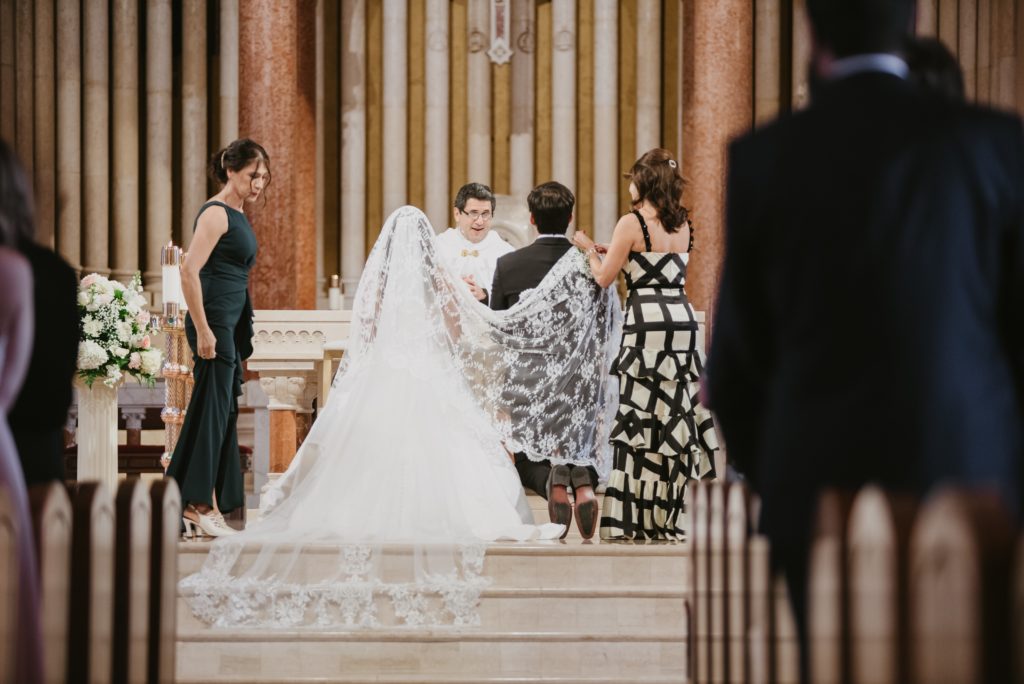Our two oldest children married recently, a son and a daughter.
Their weddings were very different, one small and simple at the height of the pandemic, the other large and fashionable in what felt like a raucous celebration of the return of normalcy. Yet the sacred motion at the center of each occasion was the same: the lifting of a couple’s love-bond into a holy one.
Each pretty tradition was accomplished — the handing over of a daughter to her groom by a wistful father, the white dress of purity on the bride, the mutual promises repeated, wide-eyed, by the couple. Every moment and gesture were pregnant with meaning — and why not? Here was a little ark sent off on its maiden voyage, carrying the whole future in its holds.
My favorite of the wedding traditions we observed is that of the mantilla, one I have only seen in Cuban weddings, although I suspect it is one with Spanish roots that came to the New World via conquistadors and “misioneros.”
A mantilla is a large shawl, made of elaborate lace-work, that was, in the past, the head cover of a properly turned-out Spanish woman. When attached with a tall, filigreed comb, it gives a haughty air to the head, as of a crown on a woman born to wear one. It goes naturally with a straight back, a stately bearing, and an aristocratic tilt of the chin.
The covering of the mantilla is nothing like the covering of the Islamic “hijab,” which is meant to hide female charms from lustful eyes. Rather, the threads of the mantilla declare for modesty and decorum, but its open spaces declare for the goodness of the gift that is a woman’s beauty, a gift like a mountain landscape or the floating night-scent of jasmine. Inspiring poets and knights, happening magically in the most squalid places, launching ships, female loveliness reminds us that God is love and truth, yes, but also, and not least, beauty.
Here is how the mantilla is used in the wedding ceremony:
While the couple are standing or kneeling before the altar, after the vows have been pronounced, the mother of the groom and the mother of the bride approach them. Each holding two corners of the mantilla, the bride’s mother places the lace over her daughter’s head and shoulders; the groom’s mother drapes the other side of the shawl over her son’s shoulders. He wears her mantle for the consecration of the water and wine and then the mothers remove it.
And here is what it means:
The mantilla is the shelter the bride offers her husband from the sun and biting wind, and from the restless roughness of the world. Under its folds is the whole genius of woman: her hospitality, her life-making, the way she smooths and gentles, orders and preserves. Where she is there are rituals and rhythms, coziness and comeliness; there is artistry in living, not just execution. In that haven there is rest for the weary, tireless attention for the helpless, steadiness of purpose, and a large calm.
For her husband the woman creates an oasis in a parched desert. Or, in a less poetic vein, she sweetens a rough bachelor pad into a sanctuary with the deft placement of a throw pillow and an insistence on coasters. She argues for framed family photos and for the keeping of tools in the shed. She asks him to build a wall around the garden, which she grows, and tighten well the fittings of the crib, which she fills. She makes the man out of the boy, and the man can’t understand how he ever lived without her.
These are the things I saw happening when the lace dropped over my son’s shoulder, and my son-in-law’s, and when I laid the mantilla carefully over the foreheads of their brides.
These are the things that happen when a man takes a wife, and with her he gains a home.

